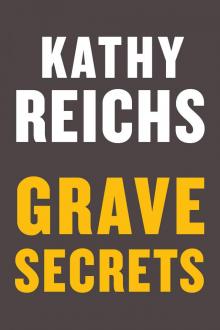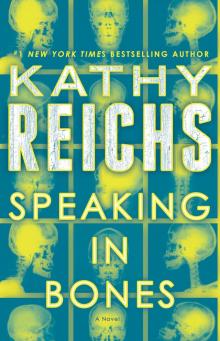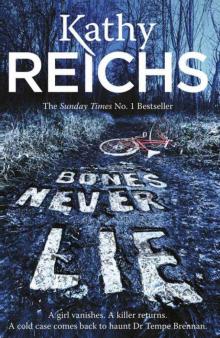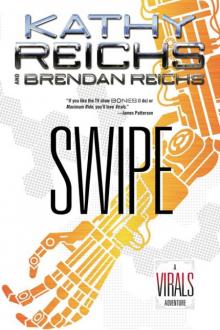- Home
- Kathy Reichs
Spider Bones: A Novel Page 10
Spider Bones: A Novel Read online
Page 10
“Hold, please.”
Perry picked up right away.
“I’m sorry. What I was hearing didn’t make sense. Lord knows what was coming through on your end.” Nervous laugh. “This phone jumbles sound when the signal gets weak.” Dear God, I was rambling. “How can I help you?”
Perry repeated what she’d said earlier. Homicide, body parts, young male, help.
“Can’t someone local assist you?”
“No.”
I waited. She didn’t elaborate.
“There are board-certified anthropologists at the CIL.” I glanced at Danny. Though he was trying hard to look focused on 2010-37, I knew he was listening.
“And they often help me out, Dr. Brennan. This time I’m asking you.”
“I’m in Honolulu for only a very short time.”
“I know that.”
Oh? I leaned back in my chair.
“Dr. Perry, I’m committed to resolving a situation at the CIL.”
“That’s military. They quit early. You can work with me after hours.”
Choosing a long bone, Danny moved to the sink.
“Why me?”
“You’re the best. You said so yourself.”
“I was joking.”
“I’m asking this as a personal favor.”
Far down the line I heard a barely audible voice, like a ghost speaking in some parallel dimension.
Or a nameless victim crying out for justice.
I glanced at Danny. At 2010-37.
“I’ll come by at five thirty,” I said. “But only for an hour.”
After disconnecting, I glanced at Danny. His shoulders had the tautness of someone who is angry or afraid.
“You overheard?”
“Enough.”
“I assume the two of you don’t get along.”
“Let’s just say Hadley Perry won’t be dining at my house real soon. But that doesn’t mean you shouldn’t help her.”
“Do you want to tell me?”
“I don’t like her, it’s mutual, we’ll leave it at that.”
Danny strode to the table. I followed. He added his freshly scrubbed tibia to the man from Lumberton.
For a moment we both stared at the half-cleaned skeleton.
“What did you want to show me?” Danny asked.
“It may be nothing.” I scooped up the occipital fragment. “Look at the suture.” I pointed to the squiggly line.
“Complex, with lots of accessories.” Danny meant tiny islands of bone trapped within the suture.
I passed him the chunk of maxilla that had produced the mushroom-duck thing.
“Broad palate. Straight transverse suture, not bulging up over the midline.” He viewed the bone face-on. “The zygomaxillary suture is angled, not S-shaped.” He rotated it so the missing nose would have pointed skyward. “Cheekbones probably had some flare.”
Danny’s eyes rolled up to mine.
“You’re thinking this guy might be Vietnamese?”
I shook my head. “You’re right those traits say Mongoloid ancestry. But others suggest Caucasoid. The high nasal bridge, the narrow nasal aperture, the moderately shaped skull, neither long and narrow nor short and broad.”
“So, mixed race?”
“European-Asian or European–Native American.”
“We had troops who would fit that bill. American Indians, Puerto Ricans, Mexicans, Filipinos. Not many, but they were over there fighting for us.”
“What about the missing crew member? Did you learn if the fourth body was ever found?”
“Not yet.”
“What was the man’s name?”
“I’m still waiting for a response to my inquiry.”
For the rest of that day we teased charred tissue and moldy fabric from bone.
By five a fully cleaned skeleton lay on the table.
The exposed bone produced no breakthrough moment.
Honolulu’s medical examiner operates out of a curvilinear white structure on Iwilei Road just a short walk from Chinatown. Next door is the largest Salvation Army facility I have ever seen.
At precisely five thirty I pulled under an arch and into a small lot beside the building. Hadley Perry answered my buzz in person. The pictures I’d seen in the Honolulu Advertiser hardly prepared me.
Perry was a slim woman with disproportionately large breasts and a penchant for what Katy called “haute hooker” makeup. Her short black hair was gelled into spikes, several of which were fire engine red.
“Hadley Perry.” She shot out a hand.
I offered mine.
Perry’s grip could have molded forged steel.
“Thanks so much for coming.”
“I’m not sure I can help.” Wiggling my fingers to check for fractures.
“But you’ll give it the old one-two, eh?” Perry launched a punch to my biceps that really hurt. “Let’s have at it.”
Good Lord. Who was this woman?
I followed Perry through double doors down a polished tile corridor, resisting the urge to massage my throbbing muscle. Bypassing a large, five-table autopsy room, we entered a small chamber not unlike salle 4 at the LSJML. Glass-fronted cabinets, side counter, dissecting scope, hanging scale.
The stainless steel gurney held a plastic-covered mound. Small and lumpy, the shape looked wrong for a human being.
Wordlessly, we both donned aprons and gloves.
Like a waiter presenting the table d’hôte, Perry whipped off the sheeting.
I SWALLOWED HARD.
The remains consisted of five amorphous lumps and an eighteen-inch segment of human lower limb. The skin was puckered and celery green, the underlying tissue gray and textured like pot roast.
Stepping to the table, I bent for a closer look.
The severed leg was sparsely populated with short, dark hairs. Bones were visible deep in the flesh, a partial femur up, a partial tibia and fibula below. All three shafts terminated in jagged spikes. Bones, skin, and muscle were scored by gouges, cuts, and parallel slashes.
“It’s a knee, right?” Perry asked.
“Left. This came from the ocean?”
“Yeah. Check out the X-rays.”
Perry crossed to a double-tiered illuminator, flipped two switches, and tapped a film lying on the box’s horizontal surface. I joined her.
An object glowed white within a segment of flesh. Bean-sized, it looked like a cartoon whitecap.
“Shark tooth,” I said.
“Yeah. There are others.” A blue-lacquered nail jabbed two more films.
“You’re thinking death by shark attack?”
Perry waggled a hand. Maybe yes, maybe no. “I see no hemorrhage in the tissue.”
Dead hearts don’t pump. Bleeding at a trauma site usually means the victim was alive when injured. No blood usually means the hit was taken postmortem.
“Could the absence of hemorrhage be explained by immersion in salt water?”
“Sure.”
“So the dismemberment could have resulted from postmortem scavenging.”
“I’ve seen it before.”
I scanned the films, each taken at a different angle. Like the knee, three other hunks of flesh contained portions of skeleton.
“That’s the pubic bone and a bit of ischium.” I indicated a plate showing part of the pelvic front.
“Good for sex?”
“Not tonight.”
“Hardy fucking har.”
I braced for an arm-punch. Didn’t come.
“The V-shaped subpubic angle, blocky pubic body, and broad ischio-pubic ramus suggest male.”
Perry nodded.
“That’s a bit of iliac crest.” I pointed to a section of the curving upper border of a left pelvic half. “It’s only partially fused to the iliac blade. Assuming male gender, to be on the safe side, I’d say you’re looking at an age of sixteen to twenty-four.”
“Sonovafrigginbitch.”
“That’s a portion of proximal femoral sh
aft, from just below the head and neck. Left, like the knee and pelvis.” I was pointing at a plate clipped to the light box’s vertical surface. My finger moved to the one beside it. “And that’s part of the left foot and ankle. Those are remnants of distal tibia, talus, and some smaller foot bones, I’d say the navicular and the third and second cuneiforms.”
“Can you get height from them?”
I considered. “No. I could do a statistical regression off measurements taken from the partial leg bones, but the range would be almost uselessly broad.”
“But you could say if the kid was very big or very small?”
“Yes. The muscle attachments suggest a robust build.”
“What about race?”
“No way. The skin appears pale, but that could be the result of postmortem bleaching or skin sloughing due to immersion in salt water.”
Human pigmentation is contained solely in the epidermis, the skin’s outer layer. Lose the epidermis, we all look Scandinavian, a fact often misinterpreted by those unaccustomed to seeing bodies recovered from water.
Perry knew that. I knew that she knew that. The answer was strictly reflex. My attention was focused on the remains.
Returning to the table, I examined each mass in turn. Then, “Where was this found?” I waved a hand over the grisly assemblage.
“Come on, I’ll loop you in.”
Degloving, Perry led me back up the corridor. We encountered only one person, an elderly Hawaiian with a bucket and mop. The man dropped his eyes when we passed. Perry did not acknowledge his presence.
The chief ME’s office looked like Danny Tandler’s on uppers. Files and papers occupied every horizontal surface—desktop, coffee table, chair seats, windowsill, file cabinets, floor. Books, magazines, and reprints teetered in stacks. Open journals lay with spines cracking under the weight of overlying issues.
The window was covered with cheap metal blinds. The walls were hung with photos of an impressively large black dog, probably a Lab. Other decorative touches included a hanging skeleton, a pair of conch shells, now repositories for rubber bands and paper clips, several ashtrays from Vegas, a fake fern, and a collection of plastic action figures whose getups and weapons meant nothing to me.
Perry gestured to the single uncluttered chair.
I sat.
Circling the desk, my host dropped into one of those winged-meshy things designed for NASA missions to Mars.
“Nice pooch,” I said. Actually, the dog looked scruffy and mean. But Southern ladies are bred to show interest in strangers. The mechanic, the receptionist, the dry-cleaning lady. Doesn’t matter. Dixie daughters exude warmth to one and all.
Dr. Hadley Perry was not an exuder.
“Day before yesterday a couple of high schoolers were snorkeling in Halona Cove, between the Blowhole and Hanauma Bay. You know it?”
Setting for the famous Lancaster-Kerr kiss, Halona Cove was known to locals as From Here to Eternity Beach. The little inlet has soaring cliffs, killer waves, and very few tourists. Accessed only by a steep, rocky path, the spot is a favorite with local teens hoping to get more sand in their shorts than Deborah and Burt.
I nodded.
“Kids spotted something on the bottom, maybe twelve feet down, in one of the rock cuts. Brought it up, dimed nine-one-one when they realized their prize was a human knee.
“Cops called me. I ordered divers, went out there myself. The girl was still tossing chunks. The boyfriend was trying for macho, not pulling it off.”
Perry worked a way too colorful nail on her blotter, brushed the flotsam with the back of one hand.
“Divers searched for over two hours. What you just saw is what they collected.”
“Got any MPs fitting the profile?”
Perry lifted a printout and read.
“Anthony Simolini, date of birth December fourteenth, nineteen ninety-three. Haole.”
“Meaning white.”
“Sorry. Yeah. Brown hair, brown eyes, five-eleven, a hundred and eighty-five pounds. On February second of this year, at approximately ten p.m., Simolini left a Zippy’s restaurant on the Kamehameha Highway in Pearl City. He was heading home but never showed. Kid’s a high school senior, big-deal athlete. Friends and family say no way he’s a runaway.
“Jason Black, date of birth August twenty-second, nineteen ninety-four. Blond hair, blue eyes, five-nine, a hundred and sixty pounds.”
“Haole,” I said.
“January twenty-seventh of this year, Black had a throw-down with his parents, stormed out of the home, vanished. Kid has a history of drug abuse, problems at school. Friends say he often talks about splitting for the mainland.
“Ethan Motohiro, date of birth May tenth, nineteen ninety-three. Asian, black hair, brown eyes, five-four, a hundred and twenty pounds. Last September Motohiro set off to circle the island by bike. A motorist saw him on the Kalanianaole Highway near the entrance to Makapu’u Point, probably on the seventh. That was the last sighting.”
“Makapu’u Point is close to Halona Cove, right?”
“Yeah. Motohiro had a steady girlfriend, was an A student, planned on attending university.”
“Not the pattern for a runaway. Also, he may be too small. I think this kid was pretty big.”
Back to the printout.
“Isaac Kahunaaiole, date of birth July twenty-second, nineteen eighty-seven. Native Hawaiian, black hair, brown eyes, six-three, two hundred and seventy-five pounds. Worked night security at the Ala Moana Shopping Center, lived at home with his parents and four of six siblings. December twenty-second, two years back, Kahunaaiole boarded a bus for Ala Moana. Never showed up. Coworkers say he was cheerful, well liked, had a good work ethic.”
“Maybe. Size sounds right.”
“Four males sixteen to twenty-two. I suppose I could expand the age range. Or the time frame. I only went back two years.”
“Given the amount of soft tissue, I doubt this kid has been dead that long.”
Perry snorted. The sound was not pretty.
“A body drops deep enough, all rules about decomp fly out the window. Add sharks to the equation, forget it. I had a suicide once, a poet from Perth. People saw him jump off Makapu’u Point. Choppers got there within the hour. Sharks had already opened a soup kitchen. The guys in the chopper watched the bastards strip the body down to bone. A month later, I get a call. A fisherman found a segment of arm inside a shark belly.”
“The dead poet?”
“Yep. Still wearing his engraved watch. In there with him I found seven corn husks, an alarm clock, a Cutty Sark bottle, and the hind leg of a dog.”
Note to self: Research shark digestion.
“Hell, if this is murder, the kid could have been buried for a while. Or stashed in a freezer, then taken out and dumped.”
“Have you queried missing boats and planes?”
“One body was never recovered following the Ehime Maru collision.”
In 2001, a Los Angeles-class fast track submarine, the USS Greeneville, struck a Japanese fishing training boat, the Ehime Maru, just south of Honolulu. Thirty-five students and crew went down with the ship.
Later, the U.S. Navy raised the Ehime Maru from a depth of two thousand feet with most bodies still on board, and divers recovered additional victims. Thanks to the Honolulu ME, all but one crew member were identified.
“Unlikely,” I said.
“I agree,” she said.
I looked at Perry. She looked at me. From the hall, I heard the old man’s mop clank his bucket then smack the floor.
I glanced at my watch.
“Now what?” Perry ignored, or missed, the obvious message.
“When you’ve done all you can, taken photos, collected samples, et cetera, clean the bones. When they’re ready, call me.”
I rose.
Perry rose.
Pointedly, I gripped my briefcase in my right hand and held my keys in my left. Sorry, no fingers available for cracking.
Approaching
Kailua Beach, South Kalaheo Avenue doglegs, crosses a bridge over Kaelepulu Stream as Lihiwai, and emerges on the other bank as Kawailoa.
Ryan called as I was entering the bridge. He wasted no time on chitchat.
“Plato Lowery is one obstinate bastard.”
“Oh?”
“The old goat refuses to provide a DNA sample.”
“Why?”
“Beats me.”
“He gave no reason?”
“He says he doesn’t need one.”
Lowery was right. He didn’t.
As my mind groped for ideas, my foot eased off the gas. Behind me, a car horn blared. So much for the aloha attitude.
“Are there any other relatives?” I asked. “I thought Plato mentioned a cousin.”
“Not that we’ve found.”
The horn sounded again. My eyes flicked to the rearview mirror. A big-ass SUV was right on my bumper.
“The Robeson County sheriff was present when I did the exhumation in Lumberton. His name is Beasley. Call him, see if has any suggestions.”
“Worth a try.” Ryan’s tone conveyed little optimism.
I arrived home as the sun was flattening into the sea.
Katy’s mood had improved buckets since the previous day. So had her appetite. In fact, she was starving. Buzz’s Steakhouse was close, so we fired over there.
The Hawaiian gods were smiling. We scored a deck table and dined overlooking Kailua Beach. I ordered mahimahi. Katy chose teriyaki chicken.
As we ate, Katy described her day. She’d spent the morning in a helicopter, the afternoon sunning on Lanikai Beach.
Lots of blocker?
Yes, Mom.
Hat?
Hm.
Skin cancer. Wrinkles. Blah. Blah. Blah.
Eye roll.
“OK. Start at the beginning. How did you get to the chopper?”
“Took a bus. TheBus, it’s called here. I like that. Direct.”
“What did you see?”
“Downtown Honolulu, the harbor, some tower with a marketplace.”
“The Aloha Tower at Pier 9. One of the premier landmarks of the state of Hawaii.”
“The pilot mentioned that.”
“Since the twenties, that lighthouse has guided ships at sea and welcomed visitors and immigrants to Honolulu.”
“He mentioned that too. Compared it to the Statue of Liberty.”

 Two Nights
Two Nights The Bone Collection: Four Novellas
The Bone Collection: Four Novellas Fatal Voyage
Fatal Voyage 206 Bones
206 Bones Bones to Ashes
Bones to Ashes Terminal
Terminal Monday Mourning
Monday Mourning Flash and Bones
Flash and Bones Cross Bones
Cross Bones Devil Bones
Devil Bones Break No Bones
Break No Bones Swamp Bones
Swamp Bones Déjà Dead
Déjà Dead Shock
Shock Spider Bones
Spider Bones Death Du Jour
Death Du Jour Grave Secrets
Grave Secrets Trace Evidence: A Virals Short Story Collection
Trace Evidence: A Virals Short Story Collection Bones on Ice
Bones on Ice The Bone Code
The Bone Code Bones in Her Pocket
Bones in Her Pocket Seizure:
Seizure: Speaking in Bones
Speaking in Bones Deadly Decisions
Deadly Decisions Spike
Spike Bones Never Lie
Bones Never Lie Bones of the Lost
Bones of the Lost Virals 03.5 - Swipe
Virals 03.5 - Swipe Exposure
Exposure A Conspiracy of Bones
A Conspiracy of Bones Shift (tory brennan)
Shift (tory brennan) Bones of the Lost: A Temperance Brennan Novel tb-16
Bones of the Lost: A Temperance Brennan Novel tb-16 Virals tb-1
Virals tb-1 Bones Are Forever tb-15
Bones Are Forever tb-15 Code tb-3
Code tb-3 Seizure tb-2
Seizure tb-2 Deadly Descisions
Deadly Descisions Spider Bones: A Novel
Spider Bones: A Novel